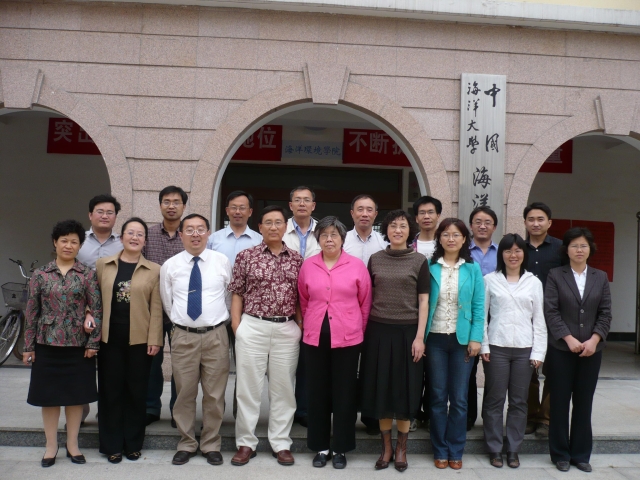Department of Oceanography
The Department of Oceanography has a history of more than 50 years. As early as 1952, the Physics group of the Department of Oceanography and Chemistry of Xiamen University was relocated to Qingdao and was merged with the Institute of Oceanography of Shandong University to form the Department of Oceanography, establishing the physical oceanography undergraduate major. In 1958, the remaining Oceanography Department of Shandong University in Qingdao was affiliated with Shandong Oceanography College. This college, newly established in 1959 and renamed the Marine Hydrometeorology Department, is comprised of two majors, Marine Hydrometeorology and Marine Meteorology. In 1971, the Physical Oceanography major was restored. In 1993, the Department of Oceanography was integrated into the College of Physical and Environmental Oceanography, Ocean University of Qingdao. Some teachers of the original Physical Oceanography major formed the Department of Oceanography, subordinate to the College. The main responsibility of the Department of Oceanography was to organize professionals from related fields to assume the task of teaching undergraduates.
The Department of Oceanography was approved to obtain the first group of master’s and doctoral programs in China. The Physical Oceanography degree was approved as a national key discipline in 1987. In 1989, the postdoctoral station of Marine Science was approved for establishment. In 1998, the Ministry of Education adjusted the specialty catalog in which Physical Oceanography was changed to Marine Science. On this basis, we successfully declared the two majors of Military Oceanography and Marine Management, both with masters programs and doctoral programs.
The Department of Oceanography in 1992 was identified as a national talents training base of scientific research and teaching. Our “Base of Oceanography” was one of the first 15 bases in China. Reviewed and accepted by the Ministry of Education in 1999, it was named one of the top five bases. Currently, there are 36 teachers in the department with more than 400 undergraduate students. The Oceanography Department currently offers 25 courses and coursework in oceanography is included in all the sea-related majors. There are five teaching laboratories undertaking teaching and research tasks of marine science. The Department of Oceanography attaches great importance to undergraduate teaching, and has won two national teaching awards as well as two national course quality awards in recent years.
Department of Meteorology

The Meteorology Department is the only teaching and research college named “Marine Meteorology”, with a long history as an important base to cultivate the talents of those studying Ocean-Atmosphere interaction, Marine Meteorology and Atmospheric Environment. As early as 1984, Marine Meteorology was included in China’s second group of PhD. programs. Currently, the Department of Meteorology has been named a doctoral degree point and a post-doctoral research station and is one of the disciplines in the “211 Project” and “985 Project” of Ocean University of China.
The history of the Department of Marine Meteorology, Ocean University of China can be traced to the Department of Physics, Shandong National University in the 1930s. In 1935 the pioneer of Chinese meteorological affairs, Jiang Binran, founded the meteorological group in the Department of Physics of Shandong National University. Then, in 1949, the meteorological group restored the Department of Physics at Shandong University. He Chongben, recently returned from the United States, and Wang Binhua, head of Qingdao Meteorological Station, were appointed as professors of the meteorological group. In 1953, four sessions of students graduated from the Physics Department. In the same year, the meteorological group of the Department of Physics was merged with the Department of Oceanography. In September 1957, with the approval of the Ministry of Higher Education, Physical Oceanography was renamed Marine Hydrology. The meteorological group extended to the Marine Meteorology major and the Department of Oceanography was renamed the Department of Marine Hydrometeorology. In October 1958, the main body of Shandong University moved to Jinan. The remaining Marine Hydrometeorology Department in Qingdao was transferred to the Shandong Oceanography Collegein 1959.
The first groupof students graduated from the Department of Marine Meteorology, Shandong College of Oceanographyin 1960.
In November 1981, Marine Meteorology became one of the first master’s degree programs in China.
In 1984, China’s State Council approved Marine Meteorology as part of the second group of doctoral programs.
In 1991, Marine Meteorology received a key award in Shandong Province.
In 1993, the College of Physical and Environmental Oceanography was established, and included the Department of Oceanography, the Department of Marine Meteorology, and the Physical Oceanography Laboratory.
In 2003, the Shandong provincial government approved the establishment of the “Taishan Scholar” post.
In 2003, degrees were granted PhD. level in Atmospheric Sciences and the undergraduate program of Applied Meteorology was established.
In 2006, the Ocean-Atmosphere Interaction and Climate Laboratory was named the key laboratory in Shandong Province.
Physical Oceanography Laboratory
The Physical Oceanography Laboratory was established in 1987. In 1999 it was recognized as one of the first group of laboratories promoted to key Laboratory of the Ministry of Education. The laboratory was attached to the College of Physical and Environmental Oceanography, but in 2010 it became an independent secondary unit as an innovative pilot of reforms. The laboratory and the college have relied on each other and developed together, each having its own focus. Currently, there are 61 members in the laboratory with nearly 40 employee by both the college and the laboratory, composed of doctoral and postdoctoral programs of Marine Science and Atmospheric Science. The laboratory is composed of innovative teams of NSFC and key fields supported by the Ministry of Science.